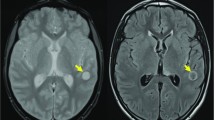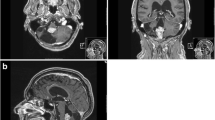Abstract
We studied nine children with posterior cranial fossa ependymomas to identify specific neuroradiological features. Patients were studied preoperatively with CT and MRI; T1-, T2-and proton-density (PD)-weighted images were obtained. All children underwent surgery and a definite histopathological diagnosis was made. All the tumours grew into the fourth ventricle and caused dilatation of its upper part, which resembled a cap. All but one were separated from the vermis by a cleavage plane. In eight cases there was desmoplastic development through the foramina of the fourth ventricle, and five were heterogeneous due to necrosis and cystic change; one had a haemorrhagic area. In most cases the solid portion was isointense with grey matter on T1-weighted images, hyperintense on PD weighting, and isointense on T2-weighted images. On CT the tumour was isodense in six cases and calcification was detected in four. The presence of both desmoplastic development and a tumour/vermis cleavage plane in a posterior cranial fossa tumour isodense on CT is highly suggestive of ependymoma.
Similar content being viewed by others
References
Atlas SW (1991) Intraaxial brain tumors. In: Atlas SW (ed) Magnetic resonance imaging of brain and spine. Raven Press, New York, pp 223–326
Barkovich AJ, Edwards MSB (1991) Brain tumors of childhood In: Barkovich AJ (ed) Pediatric neuroimaging. Raven Press, New York, pp 149–203
Ball WS, Towbin RB (1989) MRI of pediatric central nervous system neoplasms. In: Pomeranz WB (ed) Craniospinal MRI. Saunders Philadelphia, pp 177–207
Davis PC (1990) Tumors of brain. In: Cohen E. (ed) MRI of children. Decker, Philadelphia, pp 155–220
Russell DS, Rubinstein LJ (1989) Pathology of tumors of the nervous system, 5th edn. Williams and Wilkins, Baltimore
Zimmermann RA (1992) Pediatric brain tumors. In: Lee SH, Rao KCV, Zimmermann RA (eds) Cranial MRI and CT, 3rd edn. McGraw-Hill, New York, pp 318–416
Zülch KJ (1986) Brain tumors, 3rd edn. Springer, Berlin Heidelberg New York, pp 258–283
Hendrick EB, Raffel C (1989) Pediatric neurosurgery, 2nd edn. Saunders, Philadelphia, pp 366–372
Nazar GB, Hoffman HJ, Becker LE, Jenkin D, Humphreys RP, Hendrick EB (1990) Infratentorial ependymomas in childhood: prognostic factors and treatment. J Neurosurg 72: 408–417
Barnes PD, Kupsky WJ, Strand RD (1992) Cranial and intracranial tumors. In: Wolpert SM, Barnes PD (eds) MRI in pediatric neuroradiology. Mosby Year Book, St. Louis, pp 204–298
Balériaux D, Michelozzi G (1990) Tumors of the posterior fossa. In: Huk WJ, Gademann G (eds) MRI of the central nervous system diseases. Springer, Berlin Heidelberg New York, pp 277–296
Spoto GP, Press GA, Hesselink JR, Solomon M (1990) Intracranial ependymoma and subependymoma: MR manifestations. AJNR 11: 83–91
Courville CB, Broussalian SL (1961) Plastic ependymomas of the lateral recess. Report of eight verified cases. J Neurosurg 18: 792–796
Fitz CR, Rao KCV (1983) Primary tumors in children. In: Lee SH, Rao KCV (eds) Cranial computed tomography. McGraw-Hill, New York, pp 295–343
Kleihues P, Burger PC, Scheithauer BW (1994) Histological typing of tumors of the central nervous system, 2nd edn. Springer, Berlin Heidelberg New York (in press)
Rorke LB, Gilles FH (1985) Revision of the World Health Organisation classification of the brain tumors for child brain tumors. Cancer [Suppl 1]: 1869–1985
Schiffer D, Chiò A, Cravioto H, Giordana MT, Migheli A, Soffietti R, Vigliani MC (1991) Ependymoma: internal correlations among pathological signs: the anaplastic variant. Neurosurgery 29: 206–210
Kun LE, Kovnar EH, Sanford RA (1988) Ependymomas in children. Pediatr Neurosci 14: 57–63
Diebler C, Dulac O (1987) Pediatric neurology and neuroradiology. Springer, Berlin Heidelberg New York, pp 255–341
Finlay JL, Goins SC (1987) Brain tumors in children. 1. Advances in diagnosis. Am J Pediatr Hematol Oncol 9: 246–255
Chuang S (1990) Imaging of cerebral PNETs. Abstracts of the International Symposium on multidisciplinary approach to CNS tumors in childhood. Santa Margherita Ligure (Italy), p 8
Rosa ML, Capellini C, Canevari MA, Capello D, Ballerini C Roncallo F, Gentile SL, Rivano C (1991) Tumori neuroepiteliali cerebrali: correlazioni neuroradiologiche-neuropathologiche. In: Rosa ML (ed) Neuroradiologia 1991. Edizioni del Centauro, Udine, pp 21–31
Balériaux D, Marliani, AF (1990) Tumors of the posterior fossa: CT and MRI aspects. Riv Neuroradiol 3 [Suppl 2]: 67–76
Author information
Authors and Affiliations
Rights and permissions
About this article
Cite this article
Tortori-Donati, P., Fondelli, M.P., Cama, A. et al. Ependymomas of the posterior cranial fossa: CT and MRI findings. Neuroradiology 37, 238–243 (1995). https://doi.org/10.1007/BF01578265
Received:
Accepted:
Issue Date:
DOI: https://doi.org/10.1007/BF01578265




